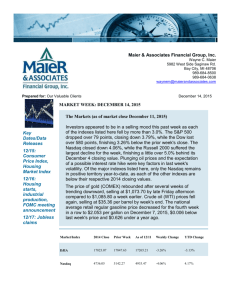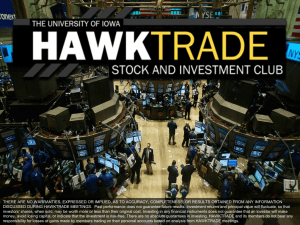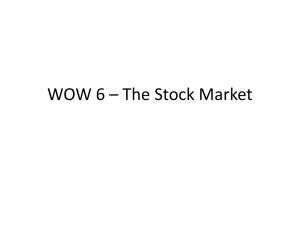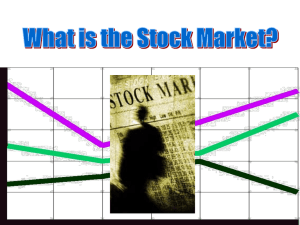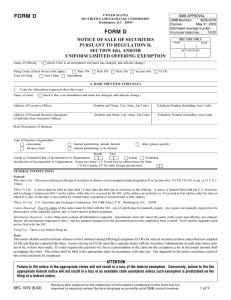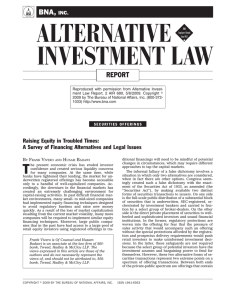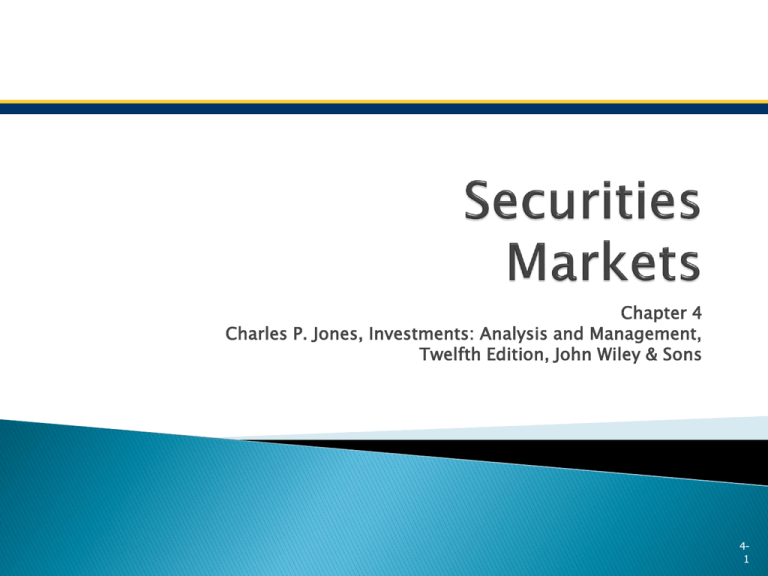
Chapter 4
Charles P. Jones, Investments: Analysis and Management,
Twelfth Edition, John Wiley & Sons
41
Channel funds from savers to borrowers
Help firms and governments raise cash by
selling securities (financial claims on issuer)
Provide a place where investors can earn a
return
Help allocate cash to where it is most
productive
Help lower the cost of exchange
42
Primary Markets
New securities are issued in a primary market
◦ Initial public offerings versus seasoned new issues
◦ Average investors do not often benefit much from
IPOs
Issue facilitated by investment banker
◦ Intermediaries between issuer and investor
Buy securities from issuer at a discount, sell them to
investors
Difference between two amounts is spread
43
Client advice includes type and features of
security, offer price, and timing of sale
Underwriting services
◦ By purchasing securities, investment bankers
assume risk of selling securities to investors
◦ May form syndicates to reduce risk
Coordinates marketing by helping issuer
register securities, issue prospectus, and sell
securities
44
Issuer
Originating investment banker
Underwriting syndicate (group) of investment bankers
Selling group of underwriting syndicate + selected retail brokerage houses
Investors
Automatic Shelf Registration allows certain
issuers to sell new securities over time after
filing a single registration
Private placement means new securities are
sold directly to investors, bypassing the open
market
◦ Registration not required
◦ Can be cheaper and faster for issuer
◦ Can lead to higher costs, restrictions
46
Markets where investors trade previously
issued securities
Allow for trading of stocks, bonds, derivatives
New York Stock Exchange/Euronext and
NASDAQ are major US exchanges
Investors are represented by brokers who
facilitate trades between buyers and sellers
for a fee
47
NYSE
◦ Has physical location in New York City
◦ Recently acquired the American Stock Exchange,
now called NYSE Amex, which focuses on small
companies
NASDAQ
◦ Electronic market of dealers (“market makers”) who
trade directly with each other and customers
◦ Gathers and consolidates quotes and orders from
participants
48
Other Secondary Markets
Over-the-Counter (OTC)
◦ Not organized marketplace or exchange
◦ Forum for securities not listed on a U.S. exchange
Better Alternative Trading System (BATS)
◦ Appeals to hedge funds, others who want speed
Electronic Communication Networks (ECNs)
◦ Offer automation, lower costs, anonymity
49
US equity markets account for a decreasing
share of world’s stock market capitalization
◦ Foreign markets include developed and emerging
markets
Emerging markets
◦ Often offer large potential for profits and large risks
Illiquidity, lack of information, political uncertainty
◦ China and Brazil have grown and attracted investor
attention
410
Stock Market Indexes
Measure only the change in prices of a
defined group of stocks over a period of time
Do not include dividends and therefore
generally understate total returns
However, price changes are primary way to
describe the performance of equity markets
411
Stock Market Indexes
Dow Jones Industrial Average
◦ Composed of 30 “blue-chip” stocks
◦ Only major market index that is price weighted
Weights high-priced stocks more than low-priced
stocks
◦ Oldest, most well-known measure
◦ Percentage change in index matters: the level of the
index does not
412
Stock Market Indexes
Standard & Poor’s 500 Composite Index
◦ Accounts for about 75% of U.S. stock-market value
◦ Expressed as index number relative to a base index
value of 10 (1941-43)
◦ Capitalization-weighted index: Prices and shares
outstanding considered
NASDAQ Indexes
Russell 1000 Index
Wilshire 5000 Total Market Index
413
Stock Market Indexes
The “correct” index depends on the investor’s
purpose
◦ DJIA and S&P 500 best for measuring performance
of large stocks
◦ NASDAQ indexes best for measuring performance
of NASDAQ stocks
◦ Wilshire 5000 best for measuring performance of
U.S. stocks in the broadest sense
414
Foreign Stock Market Indicators
MSCI EAFE Index
◦ Essentially a non-American world index (without
Brazil or India)
Dow Jones World Stock Index
◦ Capitalization-weighted (unlike the DJIA)
◦ Represents about 80% of world’s stock markets
Global Dow Index
Euro STOXX 50 and Euro STOXX 600
415
Bond and Derivatives Markets
Secondary bond markets
◦ Necessary or investors might avoid bonds
◦ Primarily an over-the-counter network of dealers
◦ Bond brokers often buy for their own accounts and
resell
Derivatives
◦ Options trade on exchanges
◦ Futures markets mostly electronic
416
Market Globalization
Electronic trading systems allow for afterhours trading
Stock prices can change even when
exchanges are closed
Bonds also being traded around the clock
Individual investors can benefit from
globalization
◦ Can trade in foreign markets and in foreign
currencies
417
Copyright 2013 John Wiley & Sons, Inc.
All rights reserved. Reproduction or translation of
this work beyond that permitted in section 117 of
the 1976 United States Copyright Act without
express permission of the copyright owner is
unlawful. Request for further information should be
addressed to the Permissions Department, John
Wiley & Sons, Inc. The purchaser may make backup copies for his/her own use only and not for
distribution or resale. The Publisher assumes no
responsibility for errors, omissions, or damages
caused by the use of these programs or from the
use of the information herein.
418

